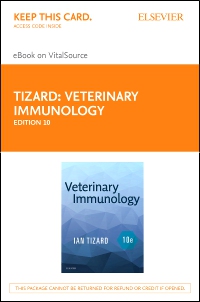
Veterinary Immunology - Elsevier eBook on VitalSource (Retail Access Card), 10th Edition
Elsevier eBook on VitalSource - Access Card

Now $85.49
**Selected for Doody’s Core Titles® 2024 in Veterinary Medicine** Exploring the immunologic concerns of both large and small animals, Veterinary Immunology: An Introduction,10th Edition is the only complete resource on immunology for veterinary practitioners. This new edition has been meticulously updated to continue its trend of incorporating the latest advances and topics in the field. It features a straightforward presentation of basic immunologic principles along with thorough and timely information on the most significant immunologic diseases and responses seen in domestic animals.
-
- Comprehensive coverage clearly explains the general principles of immunology, and provides information on the most significant immunologic diseases and immunologic responses seen in domestic animals and marine mammals.
- A wealth of clinical examples show how principles will be experienced and addressed in the clinical setting.
- Educator and student resources on Evolve feature an image collection, enhanced animations, flashcards, content updates, and a test bank for instructors.
- Improved images clarify new content and enhance your understanding.
-
- NEW! Updated content covers new T cell subpopulations, newly described interleukins; new approaches to cancer immunotherapy; immunology of fish; and new advances in genomics.
- NEW! Learning objectives have been added to the beginning of each chapter.
- NEW! Chapter on commensal bacterial will address the role of commensal bacteria in veterinary immunology and provide convincing explanations for previously poorly understood phenomena.
- NEW! Information on the pathogenesis and treatment of atopic dermatitis has been added to help inform veterinarians who treat pets with dermatologic conditions.
- NEW! Revised content on cancer immunology reflects the vast expansion of information that has been uncovered in the past five years.
- NEW! Expanded information on the role of nutrition in animal immunity offers a rational basis for examining data of those who claim nutritional benefits.
- NEW! Full-color histologic images replace black and white images to more effectively convey concepts.
-
1. Surviving in a Microbial World
2. Innate Immunity: How to Detect Invaders
3. Humoral Innate Immunity: Inflammatory Mediators
4. Humoral Innate Immunity: The Complement System
5. Cellular Innate Immunity: Neutrophils and Phagocytosis
6. Cellular Innate Immunity: Macrophages and Recovery from Inflammation
7. Sickness: The Body’s Innate Responses
8. How Immune Cells Communicate: Cytokines and Their Receptors
9. Antigens: Triggers of Adaptive Immunity
10. Dendritic Cells and Antigen Processing
11. The Major Histocompatibility Complex
12. Organs of the Immune System
13. Lymphocytes
14. Helper T Cells and Their Response to Antigens
15. B Cells and Their Response to Antigens
16. Antibodies: Soluble Antigen Receptors
17. How Antigen-Binding Receptors Are Made
18. T Cells and the Destruction of Cell-Associated Invaders
19. Innate Lymphoid Cells
20. Regulation of Adaptive Immunity
21. The Microbiota and the Immune System
22. Immunity at Body Surfaces
23. Immunity in the Fetus and Newborn
24. Vaccines and Their Production
25. The Use of Vaccines
26. Immunity to Bacteria and Fungi
27. Immunity to viruses
28. Immunity to Parasites
29. Mast Cell and Eosinophil Mediated Hypersensitivity
30. Allergic Syndromes
31. Red Cell Antigens and Antibody-mediated Hypersensitivity
32. Immune-complexes and Neutrophil-mediated Hypersensitivity
33. T Cell-mediated Hypersensitivity
34. Organ Graft Rejection and Pregnancy
35. Cancer Immunology and Immunotherapy
36. Autoimmunity: General Principles
37. Organ-Specific Autoimmune Diseases
38. Immune-mediated Inflammatory Diseases
39. Primary Immunodeficiencies
40. Secondary Immunological Defects
41. Drugs and Other Agents that Affect the Immune System
42. Immunodiagnostic Techniques
43. Evolution of the Immune System
GLOSSARY
INDEX
